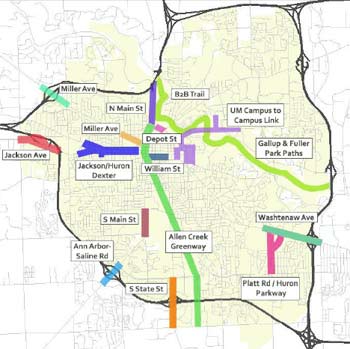Council: Give Us Non-Motorized Funding Plan
The Ann Arbor city council has directed city administrator Steve Powers to provide a funding and implementation strategy for elements of the city’s non-motorized transportation plan. The first part of the funding plan is due to the council by Jan. 1, 2014 – to enhance and improve traffic enforcement at and around crosswalks.
In its originally proposed form, the first step was supposed to cover a specific funding and implementation strategy for rectangular rapid flashing beacons that are highlighted in the non-motorized plan. But during council deliberations on Dec. 16, 2013, the council modified the resolution to remove explicit mention of specific technologies, to explicitly include mention of the city’s traffic engineers, and to include specific mention of the downtown in one of the resolved clauses. [.pdf of amended resolution]
The resolution, passed by the council on Dec. 16, came in the context of an attempt to make a significant revision to the city’s crosswalk law at the council’s Dec. 2, 2013 meeting. That change – which eliminated a requirement that motorists stop for pedestrians who were at the curb but not within the crosswalk, and was supported by a 6-4 majority – was subsequently vetoed by mayor John Hieftje. So motorists are still required to stop for pedestrians who are at the curb, even if they have not yet entered the part of the roadway marked as a crosswalk. And the text of Hieftje’s veto is attached to the council’s Dec. 16 meeting agenda as a communication.
The debate on the crosswalk law featured support from all sides for the idea that engineering (along with enforcement and education) was an important component of making the city safer for pedestrians and motorists.
The council had approved the updated non-motorized transportation plan at its Nov. 18, 2013 meeting.

Map identifying geographic areas for improvements for pedestrians and bicyclists, as noted in the 2013 non-motorized transportation plan update.
The new document is organized into three sections: (1) planning and policy updates; (2) updates to near-term recommendations; and (3) long-term recommendations.
And the original Dec. 16 resolution – which was co-sponsored by Christopher Taylor (Ward 3), Chuck Warpehoski (Ward 5), Margie Teall (Ward 4) and Sabra Briere (Ward 1) – was structured in part based on those main sections.
The amended resolution directs city administrator Steve Powers to present a plan for elements of the city’s non-motorized plan: by Jan. 1, 2014, a plan to enhance and improve traffic enforcement at and around crosswalks; by March 1, 2014, a plan to fund, effect, and otherwise implement the 2013 update to the non-motorized transportation plan’s actionable recommendations to improve midblock crosswalks; by March 1, 2014, a plan to direct the city’s traffic engineers to recommend solutions to improve pedestrian safety in downtown; by April 21, 2014, a plan to fund, effect, and otherwise implement actionable near-term recommendations of the 2013 update to the non-motorized transportation plan; and by June 30, 2014, a plan to fund, effect, and otherwise implement actionable long-term recommendations of the 2013 update to the non-motorized transportation plan.
Examples of planning and policy issues in the plan include design guidelines, recommendations for approaches like bike boulevards and bike share programs, and planning practices that cover education campaigns, maintenance, crosswalks and other non-motorized elements for pedestrians and bicyclists.
For example, the update recommends that the city begin developing a planning process for bike boulevards, which are described as “a low-traffic, low-speed road where bicycle interests are prioritized.”
Sections of West Washington (from Revena to First), Elmwood (from Platt to Canterbury) and Broadway (from its southern intersection with Plymouth to where it rejoins Plymouth about a mile to the northeast) are suggested for potential bike boulevards.
Near-term recommendations include lower-cost efforts like re-striping roads to install bike lanes and adding crossing islands.
Longer-term projects that were included in the 2007 plan are re-emphasized: the Allen Creek Greenway, Border-to-Border Trail, Gallup Park & Fuller Road paths, and a Briarwood-Pittsfield pedestrian bridge.
The city’s non-motorized transportation plan is part of the city’s master plan. The planning commission adopted the updated plan at its Sept. 10, 2013 meeting. [.pdf of draft 2013 non-motorized transportation plan update]
With respect to the adoption of the master plan, the council and the planning commission are on equal footing. That is, they must adopt the same plan. So in this case, the commission is not merely the recommending body.
This brief was filed from the city council’s chambers on the second floor of city hall, located at 301 E. Huron. A more detailed report will follow: [link]



